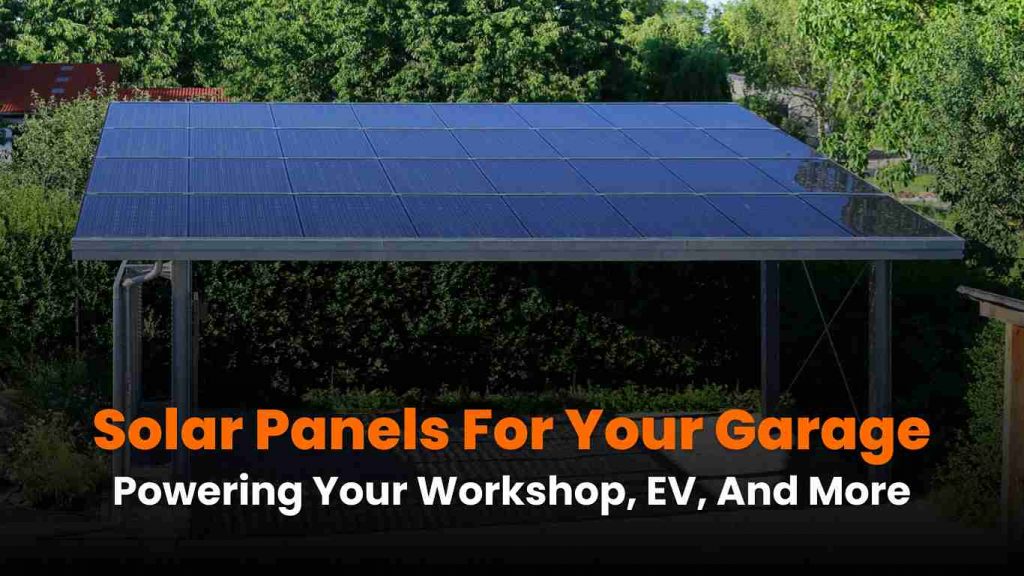Harnessing solar energy for your garage can transform it into a self-sustaining power hub. Whether you’re looking to create an energy-efficient workshop, charge your electric vehicle, or simply power your lights and doors, solar panels offer a reliable and eco-friendly solution. In this guide, we’ll explore everything you need to know about installing solar panels for your garage, from roof considerations to system configurations and the best panel options available.
Assessing Your Garage Roof: Can It Support Solar Panels?
Before investing in solar panels, the first step is evaluating your garage roof. A typical garage has around 400 square feet of available space, which is enough for up to twenty 400-watt panels. However, not all of that space may be ideal for solar installation.
For maximum efficiency, solar panels should face south if you’re in the U.S. The optimal tilt angle ranges from 30 to 45 degrees, depending on your location. Roof type also affects installation—metal, shingle, and flat roofs each require different mounting techniques.
Additionally, your garage roof must be strong enough to support the weight of the solar system. If your garage is older or structurally weak, reinforcing or replacing the roof may be necessary before installation. Consulting an engineer can help determine whether your roof is up to the task.
Choosing a Solar System Configuration: Grid-Tied or Off-Grid?
One of the biggest decisions you’ll need to make is whether to connect your garage’s solar panels to the electrical grid or operate them independently.
- Grid-Tied System: If your garage is attached to your home or located close to the main building, a grid-tied system is the most cost-effective option. Excess energy can be fed back into the grid, reducing your overall electricity bill through net metering. This ensures you benefit from your solar investment even when the garage isn’t in use.
- Off-Grid System: If your garage is detached and located far from your home, an off-grid system might be a better choice. This setup eliminates the need to run underground wiring from the house. However, it requires battery storage to keep power available at night or during cloudy days. If your energy needs are minimal—such as lighting and opening doors—you may only need a small battery.
Sizing Your Solar System: How Many Panels Do You Need?
The number of solar panels needed for your garage depends on your energy consumption. Below are three common setups:
1. Basic Setup: Lights and Doors
If you only need to power LED lights and an automatic garage door opener, your solar system can be relatively small.
- Estimated daily usage:
- LED lighting (150W) for 10 hours: 1.5 kWh
- Garage door operation: 0.15 kWh
- Solar requirement: One 300-watt panel should be enough to meet these needs, assuming five peak sun hours per day.
- Additional equipment: A small battery (under 1 kWh) can store excess energy for nighttime use.
- Inverter needed? No, as LED lights and garage doors can run on direct current (DC), eliminating the need for an inverter.
2. Workshop Setup: Lights, Doors, and Power Tools
For those using their garage as a workshop, more power is required.
- Estimated daily usage:
- Heavy-duty tools (1,500W) for 3 hours: 4.5 kWh
- Lighter tools (600W) for 4 hours: 2.4 kWh
- Solar requirement: A system with five to seven 300-watt panels should suffice.
- Additional equipment: A larger battery bank will be necessary to provide power during non-sunny hours.
- Inverter needed? Yes, to convert DC power from the panels into alternating current (AC) for power tools.
3. Full Setup: Lights, Doors, Tools, and EV Charging
If you plan to charge an electric vehicle (EV) in your garage, your solar needs increase significantly.
- Estimated daily usage:
- Tesla Model 3 (40-mile range): 15 kWh
- Workshop tools and lights: 6.9 kWh
- Solar requirement: A system with at least ten 300-watt panels (3 kW) is recommended to generate enough energy to charge an EV fully over a full day.
- Additional equipment: A high-capacity battery will be necessary for nighttime EV charging.
- Inverter needed? Yes, especially for an EV charging station.
Choosing the Right Solar Panels for Your Garage
When selecting solar panels, monocrystalline models are the best option due to their high efficiency and compact size. If aesthetics are a concern, consider all-black panels for a sleek appearance. Here are some top solar panel brands for garages:
1. REC Alpha Pure 405W
- Efficiency: 20.3%
- Key Benefits: High power density (20.3 watts per square foot), better performance in high temperatures, and a 20-year product warranty.
- Ideal For: Homeowners looking for premium performance with minimal degradation (only 8% loss over 25 years).
2. Q CELLS Q.PEAK DUO BLK-G10+/AC 365W
- Efficiency: 20.4%
- Key Benefits: Includes an Enphase IQ7 microinverter, allowing for easy AC power generation without a separate inverter.
- Ideal For: Those who want an integrated microinverter for simpler installation and maximum energy production.
3. Trina Solar TSM 365W
- Efficiency: 20%
- Key Benefits: All-black design for aesthetic appeal, strong shading tolerance, and high durability (5400 Pa load capacity).
- Ideal For: Homeowners seeking a budget-friendly option with solid performance.
Final Thoughts: Transform Your Garage with Solar Power
Installing solar panels on your garage is an excellent way to enhance energy independence, cut electricity costs, and reduce your carbon footprint. Whether you’re powering a few LED lights or running a full workshop with an EV charging station, there’s a solar solution to fit your needs.
Before making a purchase, evaluate your roof’s structure, determine whether a grid-tied or off-grid system is best for you, and calculate your energy requirements. Selecting high-quality panels from trusted brands like REC, Q CELLS, and Trina Solar will ensure long-term reliability and efficiency.
If you’re ready to explore solar panel options for your garage, check out Sunhub’s selection of top-rated panels and get started on your solar journey today!

